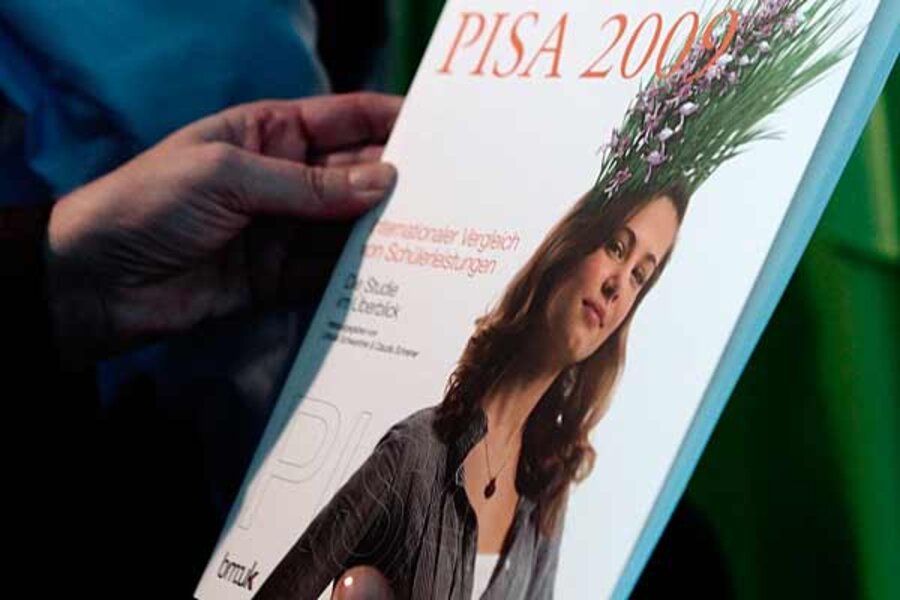US students halt academic 'free-fall,' but still lag in global testing
Loading...
American students made modest gains in science and math, but still lag significantly behind their counterparts around the world.
The latest results from the Programme for International Student Assessment (PISA) released Tuesday by the Organisation for Economic Cooperation and Development (OECD) show Asian students – particularly those from China, who participated in the exam for the first time in 2009 – at the top of the pack, with the United States generally in the middle or, in math, toward the bottom.
“We are in the middle of the pack; that’s not where we want to be,” said Stuart Kerachsky, deputy commissioner of the National Center for Education Statistics, in a call with reporters. “That’s not the goal, but all I see in these numbers is things maybe inching in the right direction.”
The test is given to 15-year-old students in dozens of countries around the world every three years, and aims to assess their reading, math, and science literacy as they prepare to enter college or the workforce. It has long been used in the US to raise alarm bells about American students falling behind in a global world.
And indeed, the most striking result from the 2009 PISA may be the top performance of Chinese students, who participated in the exam for the first time with a pilot program that tested students in several cities.
Mr. Kerachsky and others cautioned not to read too much into the comparisons, since they are from cities – those which draw many of China’s top students – and are hardly representative of all of China. But the results from Shanghai, in particular, which came out No. 1 in all three subject areas, were remarkably high.
In math, for instance, Shanghai students scored an average of 600 (on a scale with a 500-point average). Students in Korea, the top OECD country, scored a 546, and in the United States, they scored 487.
That score puts them in 25th place among the 34 OECD countries, though the score is statistically lower than just 17 of those countries, and indistinguishable from 11 others.
American students scored below the OECD average of 496. The countries outperforming the US include Finland – perennially a top-shower on PISA, along with Korea – Belgium, Estonia, Iceland, France, and the Slovak Republic, among others. US students scored higher than those in just five OECD countries: Greece, Israel, Turkey, Chile, and Mexico.
Still, there was some good news on the mathematics front, where Kerachsky notes that no countries moved ahead of the US since 2006, and the US caught up with nine countries that previously had higher average scores.
The best news for American students came in science, where they raised their score from 489 in 2006 to 502 in 2009 – on par with the average OECD score. The US caught up with six countries, and moved ahead of six other countries, though it still scored below 12 of them.
In reading – a major focus of this PISA – the US had no change in its showing from previous years. It was on par with the OECD average, and just six countries – Korea, Finland, Canada, New Zealand, Japan, and Australia – had average scores that were measurably higher.
Some experts caution that comparing countries with vastly different populations is frought with complexities, and that the rankings aren’t as straightforward as they might seem. In the US, for instance, about 20 percent of students are non-native English speakers, notes Clifford Adelman, a senior associate with the Institute for Higher Education Policy. In Korea, virtually all students are native speakers of Korean, the language in which they take the test.
“We’ve got a very motley crew here as a nation of of immigrants,” says Mr. Adelman. “That’s not an excuse, but we ought to be comparing apples to apples.”
Still, PISA has in recent years been seen as a wake-up call to Americans who once prided themselves on their education system, but have seen their students start to fall behind peers in other countries.
In a speech in North Carolina Monday, President Barack Obama reminded Americans how the Soviet Union's launch of Sputnik in the 1950s prompted increased investment in math and science education, and called this a new "Sputnik moment." "America is in danger of falling behind," he said. Obama has also set a goal for the US to have the highest proportion of students graduating from college by 2020.
“The good news is that the free-fall seems to have stopped – and it was a free-fall for a while,” says Bob Wise, president of the Alliance for Excellent Education and the former governor of West Virginia. He adds that he’s encouraged by the fact that 30 percent of US students who are low-income performed in the top quartile. “That says to me … that the child’s income level is not determinative of how well they can do.”
Still, he adds, “we’re still treading water. We’re in a kayak and some other nations have been in a speedboat.”





